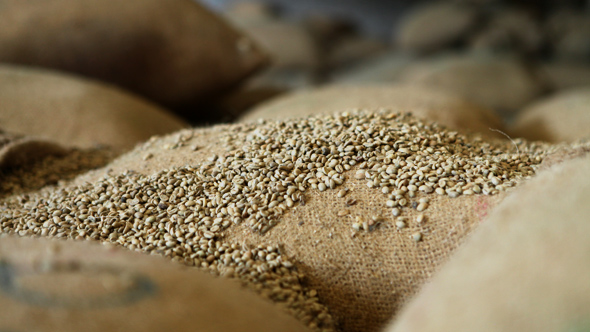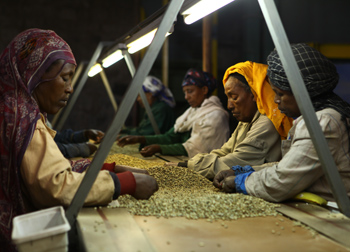Ethiopia’s export commodities and export markets: Coffee, gold and fluctuating prices
Ethiopia Sector Analysis
Ethiopia’s export commodities and export markets: Coffee, gold and fluctuating prices
‘Export is a matter of life and death for us!’—say the government officials in Ethiopia. Ethiopia is exporting more than 1,800 commodities to over 45 countries across the globe. Led by coffee—the country’s flagship export item that accounts for about 65% of the total export—, a number of agricultural products (e.g. oil seeds) and gold have also been in the forefront of export for years.

Ethiopia’s export commodities and export markets: Coffee, gold and fluctuating prices
By Bewket Abebe
ADDIS ABABA – ‘Export is a matter of life and death for us!’—say the government officials in Ethiopia. Export is thought to be the major means to secure foreign currency and an emergency treatment for a country, which has been heavily suffering from the shortage of foreign currency. To this effect, the administration’s export led policy endeavors to increase Ethiopia’s export earnings.
The current administration offers attractive incentives for exporters because it aspires to increase the contribution of export to GDP to 22.5% by mid-2015 as planned in its Growth and Transformation Plan (GTP, 2010-2015) enacted four years ago.
The country is exporting more than 1,800 commodities to over 45 countries across the globe. Led by coffee—the country’s flagship export item that accounts for about 65% of the total export—, a number of agricultural products (e.g. oil seeds) and gold have also been in the forefront of export for years. “There is a lot of potential for exports; today we talk a lot about coffee,” comments Gerard Hounkponou, chief of UN Conference Centre (Conference Coordination Unit, Conference Services Section) in Addis Ababa.

The export performance has been fluctuating
Despite the effort made, the export performance of the country has been fluctuating. The country was able to register a 15.3% of growth rate for the fiscal years preceding 2012/13. The 2012/13 fiscal year, however, didn’t herald good news for Ethiopia’s exports. The performance was disappointing when compared to the ambitious GTP. During the last fiscal year the country earned only USD 3.01 billion, which was much lower than the target for that period (USD 4 billion). As a result, the contribution of the exports to GDP couldn’t exceed 14% even though the GTP deadline is approaching.
Such low performance was mainly due to the fall of the price of coffee in the international market. “The coffee market depends on the New York Stock Exchange (NYSE),” explains Habtamu Silla, general manager of Aleta Land Coffee, which has been operating in Ethiopia for the last 14 years. “The price can go up and down,” he adds.
The price of coffee with the ICO Composite Indicator Price have recorded a 33% drop since July 2012. Such downfall of the price of coffee meant a lot of damage for a country whose export commodities are dominated by coffee (65%). Though Ethiopia exported a bigger amount of coffee in 2012/13 (199,104 tons—a 17.7% increase from 2011/12), the actual revenue from coffee exports fell by 10.4% in between 2011/12 and 2012/13.
The current administration aspires to increase the contribution of export to GDP to 22.5% by mid-2015 as planned in its Growth and Transformation Plan (GTP, 2010-2015) enacted four years ago.
(Gold) mining
The performance of the mining sector, which is known for the export of gold, was not exceptional in 2012/13. It was among those that felt short of target by a large margin. It secured only USD 596.4 million—a decline by USD 31 million from the previous fiscal year. Moreover, the decline from the target (GTP) was 26%. “You lose a lot of revenue and the country loses a lot of money simply because royalties are very important,” explains Dr. Arega Yirdaw, CEO of MIDROC Ethiopia Technology Group, the leading gold extractor in the country.
The mining industry in Ethiopia is not limited only to gold. “The resources in Ethiopia are untouched and unexplored because previously we didn’t have the right skills or technology to explore and identify our resources,” notes Tolesa Shagi, the Minister of Mines of Ethiopia. “In 2014 we are looking towards the new potential resource that is emerging in Ethiopia: potash. Additionally, intensive exploration is undergoing for oil and gas,” he adds. The minister is also explicit on the variety of untouched resources: “We have tantalum in the south of Ethiopia. We have copper, zinc and lead, which we call base metals commonly associated with gold deposits. There will also be platinum, chromium and nickel; we haven’t yet identified the deposits but the indication and potential is there.”
In addition to the fluctuating prices of commodities in the international market, the lack of diversification both in destination and the kind of commodities is believed to take a major share in the serious decline of export revenue of the country. For instance in terms of export destination, Ethiopia exports gold to only two countries and 75% of it goes to Switzerland. When it comes to the flower sector, 84% of the country’s flower export is dependent on Dutch market while more than half of the meat export is dependent on Dubai. With regard to the diversification of export destinations, it is only coffee that has succeeded in reaching more than 45 countries. Silla, who claims that his company Aleta Land Coffee sold 200 tons of coffee to Starbucks in the last fiscal year, tries to diversify his customer base depending on the price they offer. “Japanese companies give us a better price than Starbucks so we prefer to sell coffee to Japan,” he adds. This opportunity emanates from the fact that coffee has diversified destinations. Currently, Switzerland followed by China and Germany are the major export destinations when it comes to the aggregate.
 Diversification of export commodities
Diversification of export commodities
Similarly, Ethiopia is yet to improve its ambitious export performance through the diversification of its export commodities. The key commodities are those, which had been also present during the former regimes when export revenue was larger and competitive enough with larger economies. Analysts offer in this regard a wonderful example. They cite the fact that Ethiopia’s total exports were higher than those of Vietnam in the 1980s but represent just a tiny fraction today—Ethiopia’s 3 billion versus Vietnam’s 65 billion. The country’s own internal customs system, chained by cumbersome bureaucracy, is another hindering factor.
As a result, exports per person are still too low even when compared to sub-Saharan average—USD 24 and USD 200, respectively.
Manufacturing
Manufacturing exports, which are thought to be helpful in the export diversification, are showing a lingering growth. Their share in total exports declined from 14% in 1981 to 9% in 2012/13 while agricultural exports accounted for 71% of the total exports in the same year.
Flowers
But the effort is there. The horticulture sector is a show case. Entering Ethiopian market five years ago, the flower industry is another area of export that quickly grew into successful non-traditional export products. It turned Ethiopia into the second largest flower exporter on the continent next to Kenya. It took only five years until the sector fully developed—a much shorter time than in the case of Kenya, where it took about three decades. In the last fiscal year, however, even this sector witnessed a 5% slowdown from that of the previous fiscal year, and it earned only USD 186.7 million.

Textiles
The textiles—a sector that involves a large number of foreign companies, mainly Turkish—is also among the areas that Ethiopia promotes as one of the highest non-traditional export items. The GTP aims to increase the textile exports to USD 1 billion by mid-2015. Yet it only secured USD 97.8 million in 2012/13. The initial target for the last year was to earn USD 171.4 million.
Khat
Surprisingly, Khat—a green leaf flowering plant with stimulating drug content—has become one of the top non-traditional export commodities. In the 2012/13 fiscal year, Khat witnessed an increase of USD 31 million from 2011/12 and Ethiopia was able to collect USD 271.5 million. Khat is being exported to 13 different countries and the major destinations include the neighboring Somalia and Djibouti, followed by Britain and China. Due to its drug content, however, the plant has been banned in certain countries. Ethiopian government is currently working towards exporting 80% of the total Khat production and discourage local consumption. To this effect, the government imposed a tax of 5 Ethiopian birr per kilogram of Khat consumed locally in 2012.
Problematic GTP targets?
All in all, the export revenue of Ethiopia has deteriorated in 2012/13 despite the huge export potential of the country. Experts claim that the GTP targets, especially when it comes to manufacturing, were quite problematic from the very beginning. They claim the targets were not drafted by taking into account the existing situation in the country.
Yet Ethiopia remains optimistic. “With the introduction of a new policy that encourages the establishment of manufacturing and the continuous support from the public sector for the manufacturing industry, we are anticipating that in the coming years, hopefully, the share of exports will increase,” says Getachew Regassa, secretary general of the Addis Ababa Chamber of Commerce & Sectoral Associations (AACCSA).
The country is soon to export furniture that will be manufactured locally by Technostyle, a leading importer and supplier of furniture in Ethiopia. “manufacturing is a core solution to the growth of the Ethiopian economy. That’s where we come in,” explains Amelework Ghidey, the managing director of Technostyle. “We want to use Ethiopian leather and manufacture our beautiful office swivel chairs and sell them back to people who were exporting this type of product to us. That way, instead of using foreign currency to import items, we get foreign currency to export, including leather sofas. This is our plan.”
Ethiopia has a huge potential of export—no doubt about that. The potential enables the country to eye better days in its exports like those in the 1980s. Companies such as MIDROC Ethiopia Technology Group and Aleta Land Coffee remain optimistic as well. “We would still be profitable even if the gold price goes down to close to USD 1,000 simply because we have made sure our performance is efficient. If we get a high price for gold, it will be very useful,” adds Dr. Yirdaw.
FAIR USE POLICY
This material (including media content) may not be published, broadcasted, rewritten, or redistributed. However, linking directly to the page (including the source, i.e. Marcopolis.net) is permitted and encouraged.